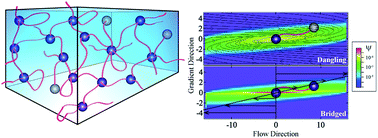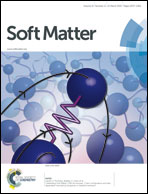Celebrating Soft Matter's 10th Anniversary: Chain configuration and rate-dependent mechanical properties in transient networks†
Abstract
Numerical solution of a coupled set of Smoluchowski convection-diffusion equations of associating polymers modelled as finitely extensible dumbbells enables computation of time-dependent end-to-end distributions for bridged, dangling, and looped chains in three dimensions as a function of associating end-group kinetics. Non-monotonic flow curves which can lead to flow instabilities during shear flow result at low equilibrium constant and high association rate from two complementary phenomena: a decrease in the fraction of elastically active chains with increasing shear rate and non-monotonic extension in the population of elastically active chains. Chain tumbling leads to reformation of bridges, resulting in an increased fraction of bridged chains at high Deborah number and significant reduction in the average bridge chain extension. In the start-up of steady shear, force-activated chain dissociation and chain tumbling cause both stress overshoot and stress ringing behaviour prior to reaching steady state stress values. During stress relaxation following steady shear, chain kinetics and extension mediate both the number of relaxations and the length of time required for system relaxation. While at low association rate relaxation is limited by the relaxation of dangling chains and the rate of dangling chain formation, at high association rate coupling of dangling and bridged chains leads to simultaneous relaxation of all chains due to a dynamic equilibrium between dangling and bridged states.

- This article is part of the themed collection: Celebrating Soft Matter’s 10th Anniversary

 Please wait while we load your content...
Please wait while we load your content...